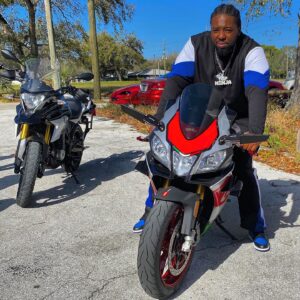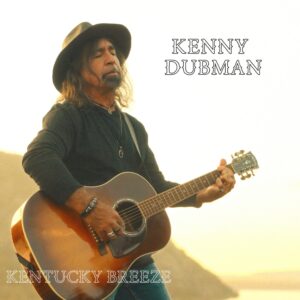
I’ll open today with Havens, who is the elder by less than a year and a half.
August 1969: American blues folk singer Richie Havens at the Isle of Wight Musical Festival.
My first exposure to Richie Havens was in Greenwich Village. Like many of my friends who grew up in New York City at the time, all of us from politically active, leftist families, I was drawn to what we referred to as “the Village.” We called ourselves “baby beatniks” as we were too young to really be part of the Beat Generation, yet too old to be dubbed “hippies,” who came slightly later. A classmate’s mom had a loft in the Village, where I got to meet Beat luminaries like Allen Ginsberg and Big Brown the street poet. We sat in outdoor cafes, drinking coffee and debating the merits of Jack Kerouac and Kahlil Gibran. We listened to street musicians like Jose Feliciano—and if lucky, we were able to sneak into performances at Village folk clubs like the Cafe Wha? owned by Manny Roth, the Night Owl, and the Cafe au Go Go. Though Havens was first a portrait artist—one of many selling their wares to tourists in the Village—later he became a part of the street beat-folk music scene.
This clip from from the Historic Films Stock Footage Archive (HFSFA) offers a glimpse of the Village scene at the time.
Now that you’ve got the Village vibes, check out Havens performing “Johnny Handsome” at the Bitter End club.
In 2011, American music journalist and author Denise Sullivan wrote about Havens’ introduction to the world of “folkies” during that period, and his journey from doo-wop to folk music.
Back in 1958, when Richie Havens was a teenage doo-wop singer in the Bedford-Stuyvesant neighborhood of Brooklyn, the kids there called him a beatnik. Not knowing for sure what that meant, he took a train with a friend to Greenwich Village to see what he could find out. “We found out these guys in the neighborhood were talking about poets, and what they might’ve thought was derogatory became a very positive thing to us,” says Havens. It wasn’t long before he was reading his own poems in Village coffeehouses. “We’d sit at a table with our little books and Ginsberg would say, ‘What’s in those books? Get up there and read them!’ That’s how it began for me. “A lot of people say, ‘What did we do? We didn’t do much.’ Oh yes we did,” he says, in answer to the cynics. “That which was a part of us was connecting up with what we were becoming at that point. And so it was wonderful to see changes. We made an atmosphere. That’s what we’re doing now. Backgrounds and atmosphere. Oh, that’s a good title! Backgrounds and atmosphere.”
Finding work in the Village as a portrait artist, he also discovered folk music in the coffeehouses and began to spend more and more nights in them, arriving later and later to the painting gig, while moving further away from his Bed-Stuy roots. He might crash in the city with singing pals like Little Anthony and the Imperials, but doo wop was no longer compelling to him, nor was the Brooklyn he knew as he watched his neighborhood and old pals take directions he wasn’t going. And so he left doo wop and a potential life in “show biz,” and became a part of what he calls the “communication business,” joining up with the folk scene. “I gave up show biz when I found a different song to sing, like Freddie Neil’s song to ‘Tear Down the Walls.’ In 1959? I’m going, ‘wow.’” “The music’s in the air, where every man is free,” sang Fred Neil on “Tear Down the Walls”, one of his early-period folk songs. “When I think about it, that’s a heck of a time, when almost nobody was asking those kinds of things or projecting them,” says Havens.
“And Dino Valenti, ‘Love is but a song we sing, and fear’s the way we die,’” he sings, quoting “Get Together.” “He wrote it in 1958! We were awakening by these songs… I couldn’t wait for them to write another song so I could sing it from the audience with them.” Havens took to singing-along, especially while Fred Neil performed, “in harmony no less,” while Neil, who had a reputation as friend-to-the-new-folkie, advised him to get a guitar and learn his own. Three days later, Havens returned to the Village and began to perform six nights a week for the next six years.
This short concert, recorded at BBC Studios in 1974, gets off to a roaring start before easing into Havens’ take on a beloved song of friendship.
In They Can’t Hide Us Anymore, Havens, along with writer Steve Davidowitz, tells his own story. Jamie Allen’s 1999 review of the autobiography for CNN included some interesting insights, including that the book’s title “refers to the thought that entered his mind as he flew over the Woodstock festival in 1969.”

Hundreds of thousands of people lined roads, crowded fields, waited for the music to begin in what became known as a coming-out party for Hippie America.”When I flew over the crowd, that’s what I said to myself,” says Havens. “I said, ‘If they put this picture in the newspaper, it’s all over for them, because now they can’t hide us anymore.'”Havens, of course, opened Woodstock. It was the cap on his career at that point, which was gaining momentum as he charted several albums in the late ’60s. He was the artist who could pen an original folk song, or take someone else’s song and transcend it into a new entity…
Naturally, Havens has a million stories to tell, like the one about the first time he saw Hendrix, playing guitar with his teeth, in a Manhattan nightclub. Hendrix was with a band he found through the musicians’ union. “I told him, ‘You don’t need to get gigs from the union. You can make your own band,'” Havens recalls. “That’s how he did it. He went down to the coffeehouse I told him to go to. A month later, I’m around the corner at another cafe. Friend of mine comes up and says, ‘You gotta hear this band! This guy was great!’ And I went around the corner and went, ‘It’s him! It’s that guy!’ He was so magical.”
During my time in New York City, I lived in several Village apartments and in others on the Lower East Side; I got to know Havens as a “friendly acquaintance.” We’d bump into each other in clubs, after-hours joints and early morning breakfast diners. One thing about him I’ll never forget? The warmth of his smile.
When he died in 2013, I wrote his obituary for Black Kos and Motley Moose.
Richie Havens—Gone to the Ancestors on Earth Day
We have all heard by now of the death of Richie Havens.
I’d like to spend a little time celebrating his life. Not just as the iconic opening performer at Woodstock, or hall of fame blues folk artist.
He was a man with a message about the environment.
Havens devoted his energies to educating young people about ecological issues. In the mid-1970s, he co-founded the Northwind Undersea Institute, an oceanographic children’s museum on City Island in the Bronx. That, in turn, led to the creation of The Natural Guard, an organization Richie describes as “a way of helping kids learn that they can have a hands-on role in affecting the environment. Children study the land, water, and air in their own communities and see how they can make positive changes from something as simple as planting a garden in an abandoned lot.
In a piece in the LA Times in 1990, “Singer’s ‘Natural Guard’ Plants Seeds for Environmental Lessons,” he said:
“You give kids something to do, and there is no gang, there (are) no street-corner drugs,” the 49-year-old Havens said at the Mt. Baldy Ranger District office of the Angeles Forest. “Under the guise of the environment, geography can be taught, sciences and humanities can be taught, and the need to get rid of poverty, homeless and drugs can be taught.” “I don’t think that it’s a far-fetched idea,”
Making a connection with gang members or gang wanna-bes is not as difficult as it might seem, said Havens, who himself escaped the 1950s gang life of Brooklyn’s Bedford-Stuyvesant. Nor, he said, is it hard to make a connection between the street-corner environment of vacant lots and the majesty of 10,000-foot mountain peaks an hour from downtown Los Angeles.
“The idea of the Natural Guard is to start in your own community,” he said. The goal is “to bring up a generation with real information about the environment, for the first time in history.”
Looking back to the influences in his life that caused him to champion environmentalism, along with social justice and civil rights, we find some clues.
Born in Brooklyn NY, to working class parents Richard and Mildred, he was the oldest of nine children. His mom’s family was from the British Caribbean. His father’s family had long time roots on New York’s Long Island, dating back into the early 1800’s, and an historical connection to an area blending Black Americans with Native Americans, near Shinnecock.
He, like many kids from that post-war era New York City, hung out and sang do-wops on street corners. But like many of us at the time he hopped a train to Manhattan, drawn to the lure of the Village.
I remember him well from that time, playing on the streets, and in the folk cafes and bars. The beatnik era was morphing into what would become a civil rights, anti-war and hippie generation. I have fond memories of playing Mixed Bag, his debut album over and over till the record wore out.
Then came Woodstock in 1969, and his cry of “Freedom” became an anthem for a generation.
Over the decades, while performing and recording, Havens preserved a legacy of struggle, like “Will the Circle Be Unbroken” from Soundtrack for a Revolution.
Along with the Civil Rights Movement, Havens also championed Native American causes and concerns.
In 1998 he announced the first annual Native American Music Awards.
In 2001 he headlined a benefit for imprisoned Ndn activist Leonard Peltier.
The Legendary Richie Havens will appear in Concert on Saturday Night
November 24th at 8 PM at the historic Provincetown Town Hall on Cape Cod.
The Mashpee Wampanoag Drum Group, The Wakeby Lake Singers will open the
evening with Honoring Songs and Prayers for Leonard Peltier.
His identification with both Black and native roots, his deep connection to the environment, and his ideological shaping through anti-war struggles all resonated in the man and his music.
I got to hear him live a few years ago, performing up here in the Hudson Valley, where he played with now deceased guitarist Bill Perry.
He also sang to help get Barack Obama elected.
I was looking forward to hearing him at an upstate folk festival, but in 2012, an announcement on his Facebook page announced his retirement from touring.
Dear Friends
As many of you already know, Richie had kidney surgery a year and a half ago. Though he did return to the stage after that for numerous concerts, he truly never regained the physical strength required to put on the kind of shows for which he’s always been known, and coupled with ongoing health concerns, the traveling and performing have simply become too hard on him for him to be able to continue. After 45 years of non-stop touring, this is a sad and unexpected reality.
From Woodstock to The Isle of Wight to Glastonbury to the Fillmore Auditorium to Royal Albert Hall to Carnegie Hall, Richie has played the most legendary music festivals that ever were, and most of the world’s greatest concert venues. But even when performing in a Greenwich Village coffeehouse or a small club or regional theater, he’s always been eternally grateful that people in any number turned up each time to hear him sing. More than anything, he feels incredibly blessed to have met so many of you along the way.
We were blessed to have heard him, or have known him.
He has joined the ancestors, and we can honor him by carrying his message to protect the earth.
Fly high, Richie.
But back to his life. One of my favorite songs from Havens’ later period is 1999’s “Zodiac.”
In typical Havens’ fashion, he called for a way for us to break down walls and barriers.
These are the twelve people who inherit the earth
You are one of them and there are only eleven others
And if you get to know the eleven others
You will be able to get along with everyone all over the world…
all over the world
Havens wanted us to find a way to come together.
***
 Taj Mahal & Band perform onstage during Day 4 of Bluesfest 2010 at Tyagarah Tea Tree Farm in April 2010, Byron Bay, Australia.
Taj Mahal & Band perform onstage during Day 4 of Bluesfest 2010 at Tyagarah Tea Tree Farm in April 2010, Byron Bay, Australia.
Like Havens, Henry Saint Clair Fredericks, better known as “Taj Mahal,” was exposed to music early in his life, his website explains.
Taj’s exploration of music began as an exploration of self. He was born in 1942 in Harlem to musical parents––his father was a jazz pianist with Caribbean roots; mother was a gospel-singing schoolteacher from South Carolina––who cultivated an appreciation for both personal history and the arts in their son. “I was raised really conscious of my African roots,” Taj says. “So I was trying to find out: where does what we do here connect to what we left there?” In the early 1950s, his family moved to Springfield, Massachusetts––a microcosmic melting pot for immigrants from across the globe: the Caribbean, the American South, Europe, the Mediterranean, Syria, Lebanon. “Music was everywhere,” he says. “Things were different in those days. There weren’t a lot of places that African Americans had to go out to entertain themselves. So people did a lot of entertaining in their homes. Friday or Saturday night, you’d move the furniture, mop and wax the floor, and set things up so people could pop over and hear all the music.
From the beginning, Taj found the blues magnetic, even as most artists around him in the Northeast were exploring other sounds. “I could hear little strains of the blues coming through––you could feel that energy in the music that was being played,” he says. “I could also feel that energy of the blues inside myself.” Piano lessons didn’t stick––“I’d already heard what I wanted to play”––so when a blues guitarist from North Carolina moved in next door, Taj found an early mentor and was off.
He spoke about his upbringing in a 2006 interview with Tony Montague for The Georgia Straight.
“My parents grew up during the Harlem renaissance,” says Mahal, speaking from Berkeley, California. “I was connected with my African ancestry through their stories. My grandparents on my father’s side came to this country from the Caribbean with a strong connection to Africa and no shame about it. As I got more involved in music one of the things that made me excited-from the time I was a child-was that clear link between our ancestors and the sounds we hear today. My interest in music has always been deeply personal-I was never all that interested in the performing and traveling.”
World Music Central’s profile of Taj Mahal emphasizes his early exposure to multiple cultures. What surprised me was the fact that despite his lifelong love of music, he went to the University of Massachusetts to study agriculture, not music. Perhaps that informed his lifelong commitment to the environment.
Springfield in the 1950s was full of recent arrivals both from abroad and from elsewhere in the U.S. “We spoke several dialects in my house — Southern Caribbean African — and we heard dialects from eastern and western Europe,” said Taj. In addition musicians from the Caribbean Africa and all over the U.S. frequently visited the Fredericks’ household. Taj became even more fascinated with roots — where all the different forms of music he was hearing came from what path they took to get to their current states how they influenced each other on the way. He threw himself into the study of older forms of African-American music, music the record companies largely ignored.
While attending the University of Massachusetts at Amherst as an agriculture student in the early 1960s the musician transformed himself into Taj Mahal an idea that came to him in a dream. He began playing with the popular U. Mass. party band The Elektras then left Massachusetts in 1964 for the blues-heavy Los Angeles club scene. There he formed The Rising Sons with Ry Cooder Ed Cassidy Jesse Lee Kinkaid Gary Marker and Kevin Kelly…
Taj tapped these experiences on three hugely influential records: Taj Mahal (1968), The Natch’l Blues (1968) and Giant Step/De Old Folks at Home (1969). Drawing on all the musical forms he’d absorbed as a child these early albums showed signs of the musical exploration that would be Taj’s hallmark over the years to come. “I didn’t want to fall into the trap of complacency,” said Taj Mahal. “I wanted to keep pushing the musical ideas I had about jazz music from Africa and the Caribbean. I wanted to explore the connections between different kinds of music.”
Taj Mahal became part of the active and amazingly eclectic West Coast blues, funk, and rock club scene (see some posters here!), playing gigs at clubs like the Cheetah, Kaleidoscope, Ash Grove, and the Golden Bear. The first Taj Mahal album I ever bought was his 1968 debut, simply named “Taj Mahal.”
x
Taj Mahal â Taj Mahal (Columbia) 1968@tajmahalblues
Musicians include Jesse Ed Davis & Ry Cooder.
“As hard & exciting a mix of old and new blues sounds as surfaced on record… in what had to be one of the most quietly, defiantly iconoclastic records of 1968.” Bruce Eder pic.twitter.com/nsFEYUKJaS
â Dig Those Old Records (@dig_old) May 20, 2020
Music critic and writer Bruce Eder’s review of the album at All Music offers an excellent description.
The guitar virtuosity, embodied in Taj Mahal‘s slide work (which had the subtlety of a classical performance), Jesse Ed Davis‘s lead playing, and rhythm work by Ry Cooder and Bill Boatman, is of the neatly stripped-down variety that was alien to most records aiming for popular appeal, and the singer himself approached the music with a startling mix of authenticity and youthful enthusiasm. The whole record is a strange and compelling amalgam of stylistic and technical achievements — filled with blues influences of the 1930s and 1940s, but also making use of stereo sound separation and the best recording technology. The result was numbers like Sleepy John Estes‘ “Diving Duck Blues,” with textures resembling the mix on the early Cream albums, while “The Celebrated Walkin’ Blues” (even with Cooder‘s animated mandolin weaving its spell on one side of the stereo mix) has the sound of a late ’40s Chess release by Muddy Waters. Blind Willie McTell (“Statesboro Blues”) and Robert Johnson (“Dust My Broom”) are also represented, in what had to be one of the most quietly, defiantly iconoclastic records of 1968.
Here’s “Leaving Trunk” from the album; it might not have garnered a mention in Eder’s review, but it’s a fantastic introduction to Taj Mahal.
During the heyday of heavy metal and disco music in the late ‘70s and ‘80s, Taj Mahal switched gears and ultimately left Los Angeles.
The 70s were a productive and ambitious recording period for Taj that included the Grammy-nominated soundtrack for the film Sounder. He began experimenting with global fusions and flirtations, signaling to listeners his restless intention to discover both new and old and disregard commercially imposed boundaries. In the 80s, Taj moved to Hawaii, and fell in love with sounds native to the island as he toured constantly, internationally. His gritty blues began to incorporate Latin, reggae, Caribbean, calypso, cajun, jazz, and more, all layered over a distinctly Afrocentric roots base he’d been raised to rediscover.
He had married Inshirah Geter in 1976. They had six children: Aya, Taj, Gahmelah, Ahmen, Deva, and Nani. All together, Taj Mahal is a father of 15. The most well known of his kids is his daughter Deva Mahal, who not only performs with her dad but has a budding music career of her own.
Deva Mahal was born with the blues in her blood. Becoming the genre-defying artist, powerhouse vocalist and astute songwriter that she is today could only be achieved through living a life rich with pain, joy, loss, love, heartache and experience. A soul as singular as Deva’s can only find voice through an equally unique sound, which she’s forged by growing her blues roots through the fertile soil of modern R&B, indie-pop, soul, rock and gospel.
Here’s a sample of Deva’s unique, sultry sound.
During his time in Hawaii, Taj Mahal hooked up with local musicians and the Hula Blues Band was formed.
He has toured with them and continues to perform with them in selected venues. Taj Mahal went on to be nominated for multiple GRAMMYs, winning four to date.
Mahal won his first GRAMMY award with the 1997 Private Music release Señor Blues, taking home that year’s prize for Best Contemporary Blues Album. The session was easily among the best of Mahal’s later career, showcasing a wide diversity of material including a country-blues take on Hank Williams’ “Mind Your Own Business,” a cover of Lowman Pauling’s “Think” (a song made famous by James Brown), and the title track – a soulful, Hammond organ laced version of Horace Silver’s timeless jazz classic, informed by the rhythms of Silver’s Cape Verdean upbringing.
Take a listen to his first GRAMMY winner.
What fascinates me about Taj Mahal is his endless reinvention of his music as he searches out new cultural bridges to cross. Robert Ambrose reviewed his 1999 collaboration with Toumani Diabaté of Mali for the Miami New Times.
It’s the age of cultural mixing, and one of the best examples of mutual musical understanding anywhere is found on Kulanjan, the recorded encounter between Taj Mahal and Mali’s Toumani Diabaté. A more natural pairing for cultural collision could hardly be imagined. Taj Mahal’s rootsy blues have always resonated with African echoes, and the American singer has identified musically with Africa throughout his long career. Toumani Diabaté is a virtuoso on the kora, a twenty-one string lute endemic to the ancient royal Mandingo culture of West Africa; his brilliance shines in his recent traditional release, New Ancient Strings. Yet Diabaté is also an experienced musical explorer, having dropped his kora into Salif Keita’s electric outfit for years, and integrating his music with the nuevo flamenco band Ketama for two classic Songhai recordings. Still, the shared empathy for two distinct musical expressions has rarely been so evident as it is on Kulanjan.
Here they are live in Paris, also in 1999. Their ability to sync up complex riffs—which also complement each other when played separately—is impressive.
Going back to his earlier career, Taj Mahal paid tribute to his Caribbean roots with his Mo’ Roots album, released in 1974. I spent many a night in clubs dancing to “Why Did You Have to Desert Me.” One of the key things that always drew me to Taj Mahal was his danceability. Nobody can just sit down and look intellectual, nodding politely, when Taj Mahal escapes a speaker. He gets you up and doin’ the do.
Taj Mahal also paid homage to Bob Marley and reggae with this cover of Marley’s “Slave Driver,” also on the Mo’ Roots album. Here’s a live version from one of his many appearances on Austin City Limits.
In 2018, Taj Mahal won another GRAMMY for Best Contemporary Blues Album, when he teamed up with Kevin Moore, known as Keb’ Mo’.
Singer-Songwriter and guitarist Keb’ Mo’s music is a living link to the seminal Delta blues that traveled up the Mississippi River and across the expanse of America–informing all of its musical roots–before evolving into a universally celebrated art form. Born Kevin Moore in South Los Angeles to parents originally from the deep South, he adopted his better known stage name when he was a young player who became inspired by the force of this essential African-American legacy. In the storied tradition of bluesmen before him including Muddy Waters–formerly McKinley Morganfield–and Taj Mahal, who began his days as Henry St. Clair Fredericks, Moore became known as Keb’ Mo’. His acclaimed self-titled 1994 debut album introduced that now famous appellation to the world.
Keb’ Mo’ and Taj Mahal also collaborated on Mo’s latest album, 2019’s Oklahoma.
For those of you who have youngsters in your lives, they might be familiar with Taj Mahal’s theme song for the long-running American-Canadian cartoon series Peep and the Big Wide World, or his four albums of children’s songs.
To celebrate his recent birthday (and support families during the pandemic), Taj Mahal posted “Free Songs For The Kids” on his website.
x
ICYMI last week: join us in celebrating Taj’s birthday with free downloads of four tracksâÂÂâÂÂone from each of his childrenâÂÂs albumsâÂÂâÂÂto help you entertain, educate, and just have fun with your little ones: https://t.co/9MWSCQrUrX pic.twitter.com/Kl85R9XzS7
â Taj Mahal (@tajmahalblues) May 24, 2020
This should be enough medicine to hold you ‘til the next Sunday installment of Black music to get you through the day. Stay tuned, post your favorite tunes to comments, and remember to stay safe, keep your distance, and wear a mask.






